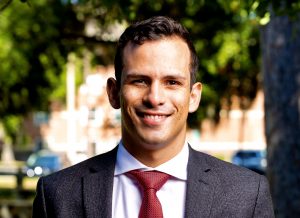By Pablo A. Hereter, University of Florida Law School
Florida’s environmental laws are stuck in the 1970s with no flexibility to deal with the crisis of sea-level rise.
Projections of sea-level rise by the Southeast Florida Regional Climate Change Compact have my hometown dealing with anywhere from 21 to 54 inches of rise by 2070. Unless we are successful in curbing the release of greenhouse gases, we may see a rise as high as six feet in the year 2100. Any way you shake it, Miami will have to face the stark reality of sea-level rise.
We cannot be naïve when it comes to the future of Miami. Our coastline is being developed at breakneck speed. Every other day it seems like there is an announcement of a new high-rise going up that will overlook Biscayne Bay, and this development does not seem close to stopping.
Yet, land is limited, and we can no longer dredge and fill to create new land. But why not?
Why has this not been considered by developers as an option. Simply put, it is due to an environmental law passed in the 1970s, the Biscayne Bay Aquatic Preserve Act.

Prior to the designation of the Aquatic Preserve, all who desired to dredge and fill had free rein to do so within Miami’s crown jewel of tourism. Star Island and many more of the islands within Biscayne Bay are a product of the dredging and filling that occurred in the early part of the 20th century. Fast forward to 1974, environmental awareness began to take a hold, so much so that two state representatives from opposite sides of the aisle, Allen Becker and John Cyril Malloy, came together to sponsor House Bill 4018, which became law.
It requires a public hearing for any dredge and fill proposal prior to its approval. The hope was that public hearings would create a legal hurdle for development and curtail or stop the discharge of effluent into the bay.
The law worked. Ending dredging and filling reduced pollution in the bay. Certainly, there are other issues that contribute to issues of water quality in the bay. However, Miami-Dade has taken steps to address them by creating the position of Chief Bay Officer.
The Biscayne Bay Aquatic Preserve Act has been a force for good. But it was created before we came to understand the threat of sea-level rise. If we impose hard restrictions on any sort of construction within the bay, it could mean creative solutions like living shorelines or natural infrastructure cannot be considered.
Yet there is legal precedent for dredging and filling in the bay. In a court case decided in 1977, homeowners wanted to dredge and fill to create a sea wall. The court decided that it was permissible as long as concessions to improve water quality were made in the construction of the wall.
In 2021, the city finds itself at a Biscayne Bay tipping point. Last summer the bay endured a massive fish kill and the death of significant amounts of seagrass. But the bay’s troubles may actually be an opportunity for officials to both save the bay and the land surrounding it by loosening the restrictions of the 1974 law, by following the legal precedent set out in the 1977 court case.
Echoing the bipartisanship of 1974, the bay’s current crisis lends itself to bringing together two communities that are often at odds – conservationists and developers. They need to work together to create innovative solutions to save the bay. Easing restrictions on dredging would make it easier for both groups to achieve their goals.
The development community is eager to protect the bay. For example, Swire Properties Inc., a South Florida developer, and the engineering firm of Moffat & Nichol proposed in February to create barriers in the bay to dissipate wave energy, submerged oyster reefs, and earthen berms. These are viable nature-based solutions beyond just sea walls.
The rigid restrictions of the Biscayne Bay Aquatic Preserve Act — although desperately needed in the 1970s – are too limiting in this era of sea-level rise. We need to reframe the act to give people more flexibility to protect the bay and, in turn, the future of Miami-Dade County.
Pablo A. Hereter is a rising 3rd year student at the University of Florida Levin College of Law and Summer Intern at the Miami-Dade Office of Resilience. He’s an alumnus of Belen Jesuit Preparatory and Florida International University. Born and raised in the city that means the world to him, Miami.
“The Invading Sea” is the opinion arm of the Florida Climate Reporting Network, a collaborative of news organizations across the state focusing on the threats posed by the warming climate.



